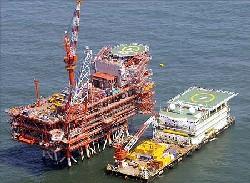When Reliance Industries Ltd (RIL) started pumping natural gas from its D-6 block in the Krishna-Godavari (K-G) basin, in April 2009, there was little euphoria in the industry, beaten down by the global economic slowdown. But D-6, being the first deepwater block in India to start production, made history. The block's output touched 62 million standard cubic metres a day (mscmd) in March 2009, pushing the country's GDP an estimated 0.3 per cent during 2009-10.
But D-6, being the first deepwater block in India to start production, made history. The block's output touched 62 million standard cubic metres a day (mscmd) in March 2009, pushing the country's GDP an estimated 0.3 per cent during 2009-10.
At the end of its two-year dream run, however, things look bleak. RIL's D-6 production has come down to 50 mscmd and there are doubts over its touching the level of 60 mscmd in the near future.
None of the other major discoveries made by the government-owned Oil and Natural Gas Corporation (ONGC) and Gujarat State Petroleum Corporation (GSPC) are expected to start production anytime soon.
Domestic gas demand, estimated at over 300 mscmd, is already unmet, and the deficit will further rise if the production falls.
The question being asked is whether the dream of a thriving gas economy has soured even before fully fructifying.
February saw the share of natural gas in the country's total hydrocarbon production coming down to 46 per cent, from 54 per cent in the same month last year.
In contrast, crude oil production outpaced gas production, rising to 298,6000 tonnes in February, compared to 294,8386 tonnes oil equivalent of gas.
In the period between April 2010 and February 2011, gas and crude oil production stayed neck and neck.
"We believe, in the medium term, the percentage contribution of domestic gas would increase after the production from RIL's KG-D6 stabilises, and GSPC and ONGC gas fields in the K-G basin commence production," says Rakesh Jain, general manager (energy division), Feedback Ventures.
RIL has already invested about $6 billion in the block since 2002, but it is still encountering technical problems.
Though the Directorate General of Hydrocarbons (DGH) has made some statements on drilling of more wells, the company maintains that is not an issue.
"We are carrying out technical review so that we have an idea about the exact requirements. The aim is to optimise production over a long period," said an RIL executive who did not want to be identified.
Though oil and gas coexist in sedimentary basins, major finds in India have been of gas, not oil.
"Oil discoveries are becoming smaller and fewer in numbers. Majority of our huge discoveries, in K-G and Mahanadi basins on the East Coast, are of gas. Plans are afoot to start production from those soon. In our future profiles, we see that gas will play a dominant role," says ONGC Director (Offshore) Sudhir Vasudeva.
In the case of ONGC, the company has made 16 discoveries in the East Coast itself. Gas production is estimated to rise from about 63 mscmd this year to 68 mscmd in 2011-12, and 73 mscmd in 2012-13.
ONGC started production of small quantity of gas from its C-Series field last year and expects its first gas from GS-15 by May 2011.
Though gas production from these fields adds to the supply, that is like a drop in the ocean.
"From a long-term viewpoint, the country requires more gas and, for this, domestic production should increase. There is a need for more discoveries like D6," says A K Balyan, managing director and chief executive officer, Petronet LNG Ltd.
Balyan, who was earlier a director with ONGC, says RIL has a much larger block area and good reserves, so more drilling will help it, though he agrees that cap on natural gas prices can disincentivise companies operating in deepwater drilling.
According to him, gas can get customers even with high prices, as it would still be cheaper than liquid fuel.
For instance, the price of petrol in British thermal unit works out to around $42 and furnace oil to $22 in some cities, compared to an average of $7-8 for domestic natural gas and regassified liquefied natural gas (RLNG).
The importance of price can also be seen in the fact that an increase in price of gas from nominated fields last year helped ONGC develop its marginal fields, which were smaller in size and viable to produce only if there was a good price.
"These fields were not techno-economically viable earlier. These are now being made viable through induction of state-of-the-art technology optimisation of facilities and regrouping of fields through cluster developments," says Vasudeva.
Some of the marginal fields like D-1, SB-11 (Vasai West), Vasai East, C-Series and B134A have already started production.
Others like B-193+, B-46+, B-22+, Cluster 7 and North Tapti are under various stages of development.
Besides these, feasibility reports of a few other marginal fields are under various stages of preparation.
These are likely to come on stream in a progressive manner, starting with North Tapti and B-22 cluster from this year.
Though future holds promise for gas production, what is worrying is that the shortfall in domestic gas production has come at a time when the global LNG prices are expected to go up.
The March-11 earthquake in Japan caused nuclear and coal-fired power stations in the country to shut down, turning heads towards LNG to make up for the lost supply.
"This sent contracts soaring towards two-year highs. Around two-thirds of Japan's natural gas consumption is for power generation," says a Platts report.
Japan is the world's largest LNG importer, accounting for 48 per cent of the world's total imports in 2002.
Natural gas meets 12 per cent of Japan's energy needs, with more than 95 per cent of that being imported as LNG.
The Asian LNG market, already bullish, rose 50 cents when the 8.9-magnitude earthquake hit northern parts of Japan.
According to the report, the April Japan Korea Marker reached $9.90 per mBtu, as sellers withdrew their offers.
Spot Asian LNG is hovering around $11-12 and, after regassification and taxes, comes to around $16 a British thermal unit.
"It is unfortunate that we were not able to tie up additional LNG when prices had fallen and the gap between RLNG and domestic gas was low. But long-term contracts were not available then and are still difficult to tie up," says a senior government official.
Besides prices, pipelines are another constraining factor. ONGC, for instance, has been supplying gas in bulk to GAIL for almost two decades, while GAIL has developed the mid-stream and downstream gas pipeline infrastructure to deliver gas to customers.
ONGC also supplies a small quantity of gas directly to consumers where GAIL does not have a pipeline network and consumers are willing to take gas from ONGC premises through their gas supply network.
"ONGC has discovered huge quantities of gas in northeastern states of India, especially Tripura, where GAIL does not have a pipeline network. This is a big constraint for us," says Vasudeva.
Though ONGC is setting up a power plant through joint venture to utilise this gas in Tripura, there are similar problems in South India, where isolated pools of gas exist but cannot be produced due to non-availability of pipeline networks.
Unlike crude oil, an area where the country depends on imports and is pressured by high prices, the natural gas market in India is not constrained by high global prices.
The challenge here remains sustaining production levels and beefing up the market through better connectivity.







